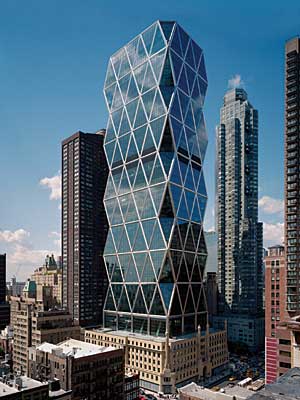Paul Goldberger is the architecture critic of The New Yorker.
 Paul Goldberger | |
“I DON’T SEE THE REGIONAL differences in design that were apparent in the past,” states Paul Goldberger when asked what American architecture looks like from his perspective at The New Yorker. “Trends today are national or even global. Sustainability is certainly one. We should be doing more on this, but we’re doing more than we did in the past.”
He also talks about “the democratization of architecture,” a process that in recent years has brought Modernism to the masses, or at least, to a larger audience. “What you can get at Ikea and Crate & Barrell is a lot better than what most people used to buy for their homes. At the same time, major architects are finally getting to design large commercial developments in New York,” he says, mentioning Norman Foster’s Hearst Tower, Frank Gehry’s Atlantic Yards complex, and Renzo Piano’s New York Times Building. “The results are mixed. When things move into the mainstream, they inevitably get compromised. I think, though, where the center of the dial has moved is more important than where the cutting edge is.” He is also encouraged by a growing audience for architecture within the general public, noting the popularity, for example, of the Web site Curbed (curbed.com). “It’s gossipy and sometimes it’s silly, but it shows a growing level of engagement with the built environment.”

Hearst Tower
Modernist architects have even penetrated that bastion of middle-brow design: the New York City apartment house. “Glass has become the new white brick,” says Goldberger. Transparent residential towers by Richard Meier, Jean Nouvel, Herzog & de Meuron, and others are rising in Manhattan and Brooklyn. He notes, though, that there is still room for buildings such as Robert A.M. Stern’s 15 Central Park West, which captures the spirit of the great apartment houses built in New York between the two World Wars.
While New York is finally getting major buildings by star architects, Goldberger notes, “I’m fascinated by the extent to which provincial places in the country are willing to take more risks than cities like New York and L.A. I’m thinking of Zaha in Cincinnati, Steven Holl in Kansas City, and SANAA in Toledo. I’m also intrigued by the time lag between when major architects first build in the provinces and when they finally get to do so in New York. For example, Gehry built in Toledo long before he did anything in New York. How many years was it between Meier’s project in New Harmony, Indiana, and his apartment towers on the Hudson?”
Reviewing New York’s recent crop of high-profile buildings, Goldberger cites SANAA’s New Museum as a “significant” addition to the city’s architecture. “It manages to straddle an industrial aesthetic and an intellectual approach to design. And it brings a distinctive young firm to New York.” He also approves of Foster’s Hearst Tower. “I like the way it challenges our intuitive perception. It seems at first like the wrong way to add onto the Joseph Urban base. But it makes us realize that the Urban building isn’t really about Classicism; it’s about an almost bombastic expressionism. Foster’s design captures that spirit.” As for Renzo Piano’s New York Times tower, Goldberger says, “It’s not the transcendent building some people had hoped for, but it’s still one of the best buildings of the past few years.”
Reviewing what is happening at Ground Zero, Goldberger calls it “a sad story. In many ways, it merely reflects where we are today. It’s a commercial development, not a civic place. And it isn’t effective urban design.” Warming to the topic, he talks about “the relative withdrawal, even abandonment, of large-scale planning by the public sector. It’s giving way to private developers, letting them take charge of what gets built where. At the end of the day, it’s not real planning.” A reason for this withdrawal is the government’s inability to build urban infrastructure on the scale that is needed. “What we’re seeing is the development of parallel infrastructures—one built by the private sector and one by the public. I can imagine a time in the future when some people might have little interaction with the public infrastructure.”




Post a comment to this article
Report Abusive Comment